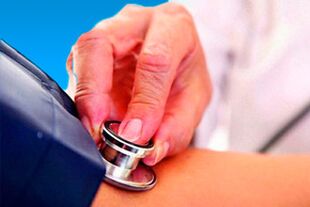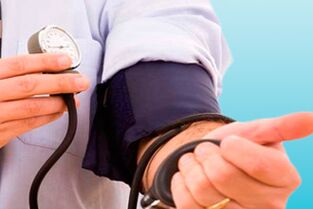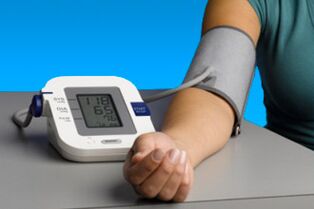
Violation of blood pressure provokes the failure of the whole body. Although this disease cannot be completely cured, the course of the disease can be less noticeable and problematic for the patient.
Michen Orgons
Arterial hypertension is a chronic disease associated with increased pressure within the vascular walls. In this case, it is very important to distinguish between rare situations when a person increases the pressure and the real manifestation of the disease. Single growth can occur for various reasons and often do not repeat it soon. This may be due to a person's excitement, hormonal defects or injuries.
Applying the question of arterial hypertension is to manage the term "hypertension". This is a temporary increase in blood pressure above 140/90. However, hypertension in medicine is called a condition in which man has stable high indicators. They rarely fall under the numbers in themselves.
The negative side of this disease is that not only the cardiovascular system suffers from chronic pressure. In medicine, there is something like target organs. The essence of the problem is that the ever -increased blood pressure has a negative effect on many organs - the heart, kidneys, brain and retina. The disease is negatively affected by the whole body, but is primarily suffered. Even the principle of classification of the disease depends on which body was negative.
The stages of illness
The disease has various forms that depend on the principle to be classified. They may depend on origin, path and blood pressure. The simplest form of arterial hypertension is the simplest, as patients can find out at home.
As with other diseases, there are several degrees of the development of hypertension, which are exacerbated only without the necessary treatment. There are norms that help determine the stage of the disease. It is not possible to draw conclusions after one or two measures of a person's pressure, as this approach can give incorrect indicators. If a person had taken certain drugs in front of a person, or there was an emotional wave and there was no more emotion bad or good, then the indicators could change. This does not allow the patient's health.
Do not mix high pressure within the normal range with the manifestation of arterial hypertension. The 120/80 pressure is considered normal for the human body, but the pressure can also be classified as 129/84. The pressure is increased to 139/89 but is not classified as certain hypertension. Hypertension is considered a pressure that exceeds 140/90.
Table 1. The degree of hypertension and pressure levels
| Norm | Between 120/80 and 139/89 | 1 degree high blood pressure | Between 140/90 and 159/99 | 2 high blood pressure | Between 160/100 and 179/109 | 3 degrees of high blood pressure | 180/110 and above |

In addition to defining "hypertension" and classification of the disease, there is a unit for primary and secondary hypertension. It develops as a primary independent pathology, and in this case other problems are often found in the human body. When it comes to secondary hypertension, this is the result of existing diseases of the human body.
The first grade
It is considered a mild form of the disease, the blood pressure indicators do not exceed 160/100, and the attacks, especially without serious consequences. The arterial hypertension of degrees 1 is characterized by cramping disorders in the heart of the heart. Aggravation periods can hardly be called rare, but due to the small manifestation and chronic process of the disease, the patient suffers quite easily. The aggravation alternates with normal indicators, during this period the patient does not feel the symptoms of the disease.
Pressure measurements should be performed several times a day for a proper assessment of the situation. This is usually done three times a day in the absence of emotional explosions or other reasons that can affect short -term change in blood pressure.
Degree arterial hypertension has its own symptom, which patients often cannot detect seriously. The disease can occur with headache, rapid heartbeat or pain on the left side of the sternum. Patients are often disturbed by the fact that first degree of hypertension is rarely characterized by symptoms.
But even hypertension may have a slight complications that have severe disorders in the human body. This:
- Cerebral micro -infarries;
- Myocardial hypertrophy;
- nephrosclerosis.
It is wrong to assume that degree 1 arterial hypertension can pass without a trace when treated with medicines. It is debatable that patients with first degree hypertension have the risk of complications. The statistics of such probability are approx. 15%.
When the patient is diagnosed with degrees of hypertension, the situation is as follows: high pressure can be triggered by narrowed gaps of blood vessels, leading to inadequate nutrition of body tissues. In the cells, necrosis develops in the absence of normal amounts of nutrients and oxygen. Initially, this process is not noticeable, but over time, the patient's body in some organs, and not only certain cells, can occur over time. Lack of treatment provokes ischemic stroke.
If the patient has a high blood pressure, degrees 1 degree hypertension still pose a very high risk for the development of heart problems.
Changing indicators in a higher direction results in further load on the heart, which tries to pass blood through the narrow deficiencies of the blood. Everyone knows that the muscles start to grow with further load, which also happens to the heart tissues. Degree of risk seems to reduce the risk of high blood pressure as the heart is able to pump blood more effectively, but this is not entirely true. Cardiomyopathy can press the blood vessels nearby and even provoke death.
The second grade

In the second degree of arterial hypertension, the patient will be at 180/110 hg. In this case, patients in patients are much higher than in degrees of hypertension at 1 degree, the risk of complication, which is less common.
The second degree of hypertension is characterized by the fact that the pressure occurs extremely rarely at normal, may decrease and increase, but does not reach the allowable limits. Degree hypertension usually has the risk of getting into degree 2, and the appearance of benign or malignant arterial hypertension can be determined. To clarify what arterial hypertension is, what kind of risks are carried and the risks of pathology.
In patients, the problems of vascular deficiency, heart pulsation, hyperemia, visual and hypertension crisis are given to the already known symptoms. The problem of the latter is that the pressure can change drastically with 59 units, which negatively affects the patient's body. In the second degree of hypertension, complications are possible:
- brain thrombosis;
- aortic aneurysm;
- atherosclerosis;
- Angina pectoris;
- Encephalopathy.
The peculiarity of this degree of hypertension is that the defeat of the target organs occurs. In patients with such diagnosis, bleeding is possible in one organ. The reason for this is that at the later stage of arterial hypertension, blood vessels lose their earlier elasticity and collapse much more easily. There is also a serious risk of formation of blood clots on the walls of the blood vessels, the lumen in which it is reduced.
Due to serious problems in the second level of arterial hypertension, the patient may receive disability. Most often they give 3 groups. But this does not mean that it is enough for the patient to measure his pressure several times and show that it exceeds the allowable norm. The Commission takes into account the complications that arise in the background of the disease, collects information on hypertension and the patient's working conditions - only then can we talk about obtaining a cash benefit.
The Commission takes into account the complications that arise in the background of the disease, collects information on hypertension and the patient's working conditions - only then can we talk about obtaining a cash benefit.
The paradox of the situation is that some patients try to get this help with the first symptoms, while others are hiding their disease on the contrary. This is most often done by employees who rely on (more sick leave, annual leave growth). But we must not forget that in the second degree of hypertension, a further load can have severe consequences, which rapidly exacerbate the disease.
It is worth noting a special case that is possible in the second degree of arterial hypertension. For malignant pathology, the Commission can order 2 disability groups. Men over 60, women over 55, and patients with irreversible mistakes have found disability in their lives. This means that you do not need to hand over the commission every year to strengthen the status.
The third grade
The degree of the disease can be determined by the pressure of a person. When the indicators begin to reach extremely high speeds at 180/110 hg, the patient is diagnosed with a third degree of severe hypertension. In this case, the complications are very serious, most of which can lead to death with early care for medical care. It may be stroke, heart asthma, myocardial infarction, kidney failure and other diseases.
By assessing the severity of this degree, patients receive 1 group of disabilities. By assessing the risk of developing diseases, the patient should be rehabilitated without failure. There is no need to talk about handling this stage, but this approach helps to avoid premature death.
The fourth degree of hypertension has the concept of fourth degree. In this case, it is quite difficult for a person to help because it is practically on the verge of death. Medicines help relieve symptoms and sharply reduce pressure levels. Hypertension crises are pronounced and very common.
The degree of risk
Usually when the patient is diagnosed, the degree of disease and the risk is indicated. This indicator can affect age, gender, obesity, bad habits and other factors.
There is a four degree risk. The most optimal hypertension of the risk of grade 1 is taken into account, with a low probability of developing lateral diseases, less than 15%. Degree 1 (risk 2) Arterial hypertension is one of the most popular diagnoses. The reason for this is that few patients live a lifestyle that does not complicate the disease. If the arterial hypertension of degree 1 is diagnosed (risk 2), the likelihood of complications ranges from 15% to 20%.
The risk of 3 degrees is a 20-30% probability of the development of diseases. Called high. There are 4 degrees when the likelihood of developing pathologies exceeds 30%. All the forecasts for risk are calculated over the next 10 years in the absence of changes in the patient's lifestyle.
Depending on the lesion of the patient's internal organs, doctors indicate a phase and extent of hypertension due to indicators. The stage of the disease determines which organs are damaged.
There is actually no indicator in stage 1 of the disease because only the pressure increases and the human organs are not damaged. With the hypertension of Stage 1, the patient will have optimistic forecasts for the future.
During the 2 stages of the disease, the first signs of reducing the vessels are found, plaques appear, and creatinine increases in blood plasma. All changes in the internal organs generally do not progress with severe changes and complications can be prevented by proper treatment.
Unlike Section 2, the third is characterized by specific diseases and not only partial changes. It is pronounced arterial hypertension, which means that the risk of myocardial infarction, stroke, cardiovascular failure and other typical diseases in patients increases several times.
The characteristics of the disease

Arterial hypertension is common throughout the world and is the most common in developed countries. Above all, the reason for this is that active life means communication with many people, and this involves different emotions, both bad and good, which exerts constant pressure.
It is not difficult for many to answer what is? The prevalence of the disease allows this pathology to be called the Pest of the 21st Century. There are things like arterial hypertension syndrome, chronic vascular deficiency, the same hypertension. Violation of blood vessels provokes arterial hypertension syndrome.
Pregnancy arterial hypertension is extremely negative for a woman. The appearance of this pathology is related to pregnancy, during this period a woman is contraindicated in taking most medications.
However, the lack of treatment can have extremely negative consequences. Statistics show that pregnancy arterial hypertension is caused by about one -third of the fatal outcome of the mother during childbirth and can also provoke the death of the fetus or the death of premature birth.
In addition to the patient should be aware of the symptoms of hypertension and what it is in time to contact the hospital, as the treatment of the disease in the first stage is much easier. Consultation should be consulted with an increase in the dose or involving other medicines. Mediation alone can exacerbate the disease.























